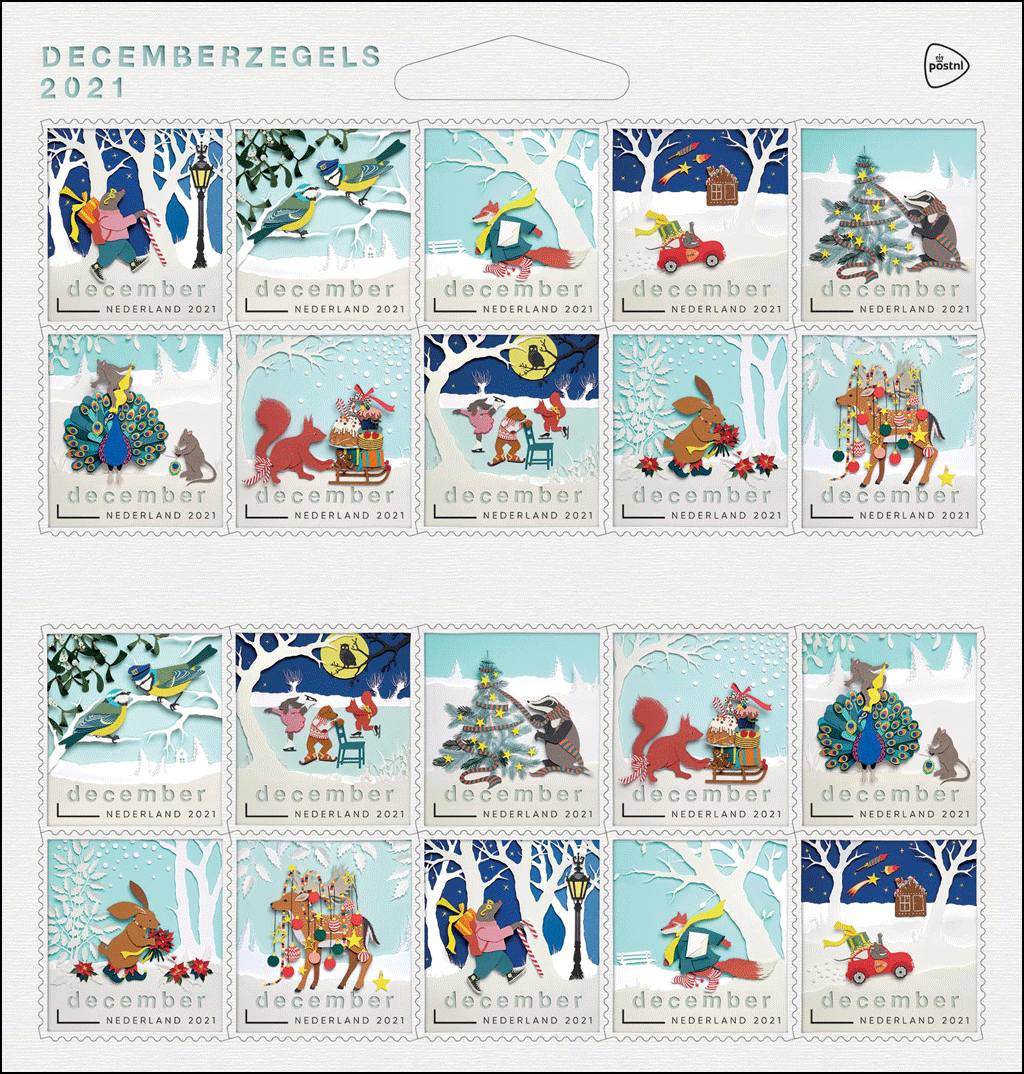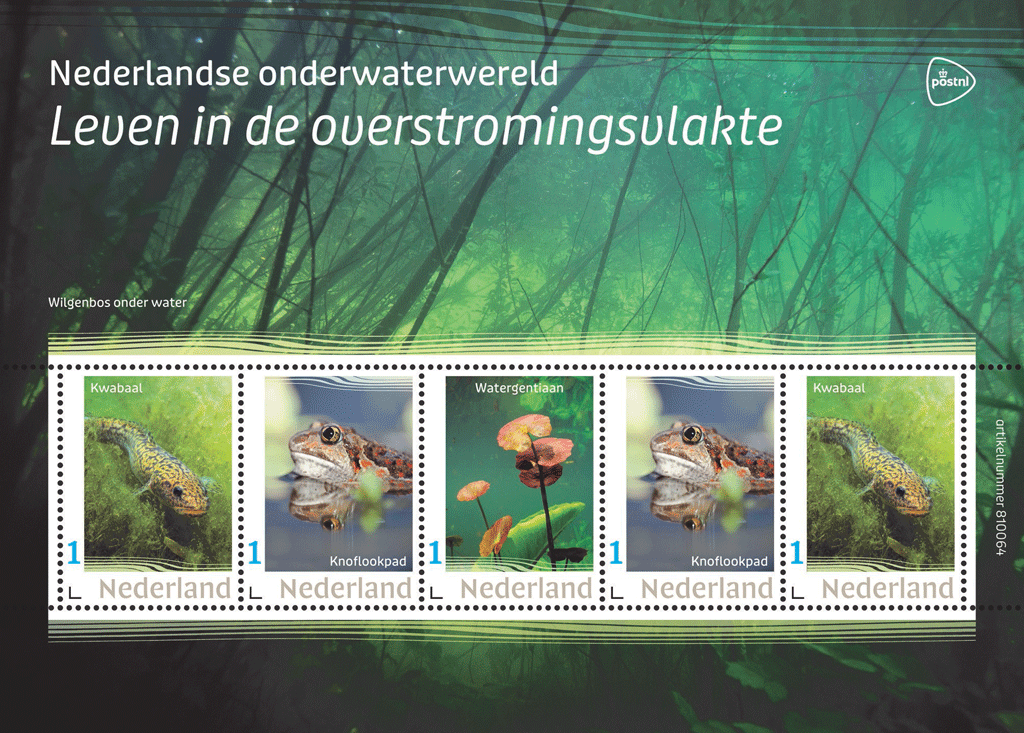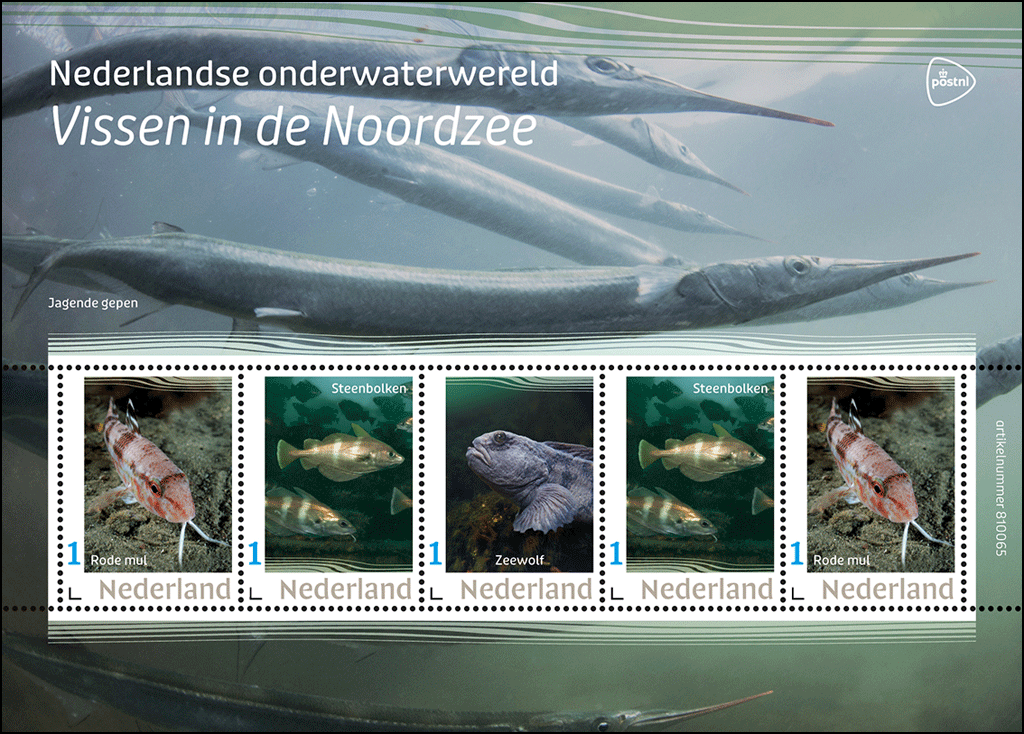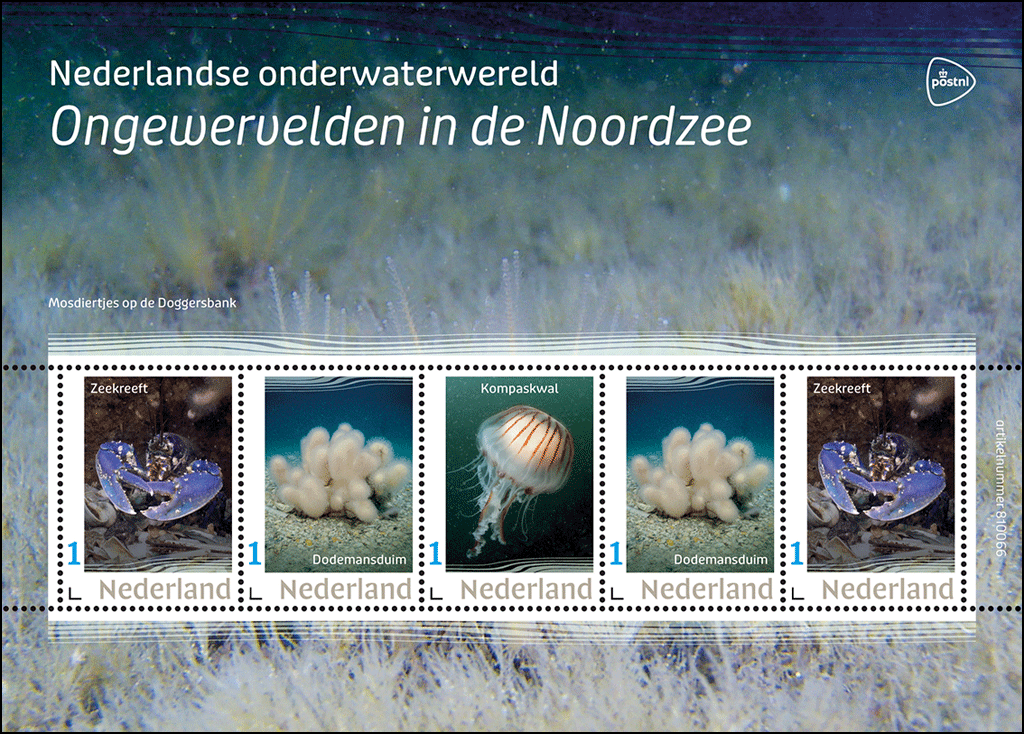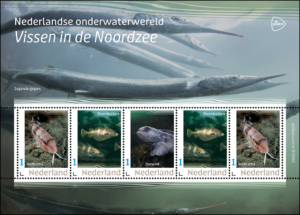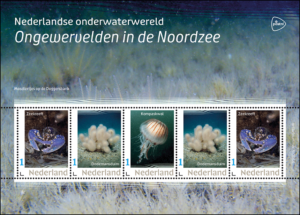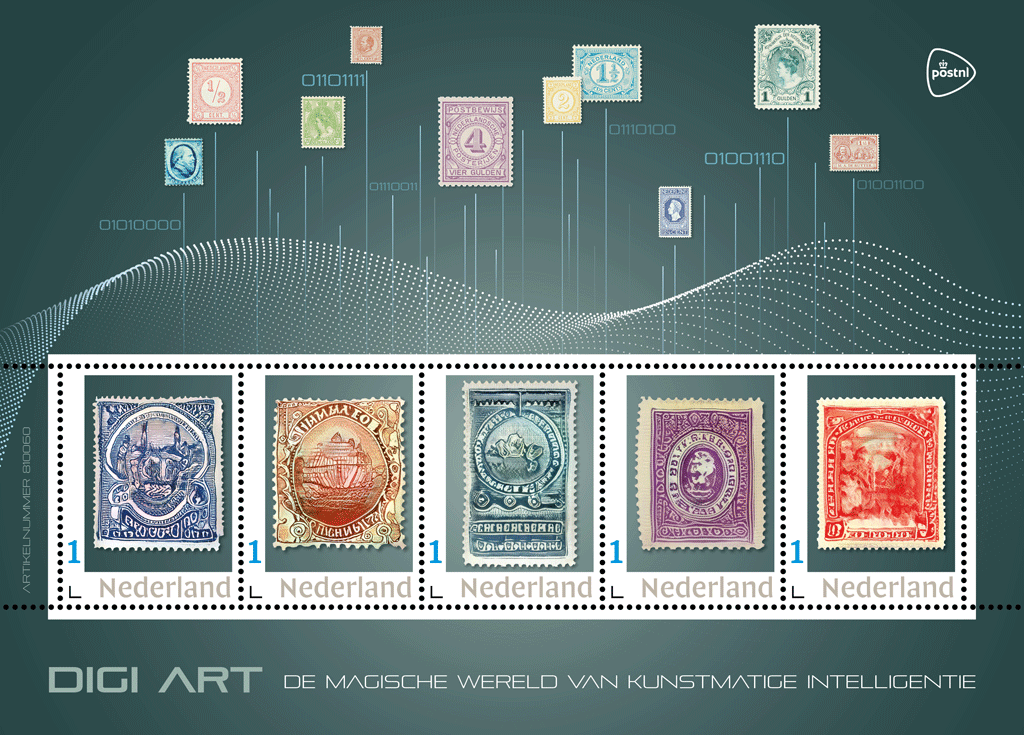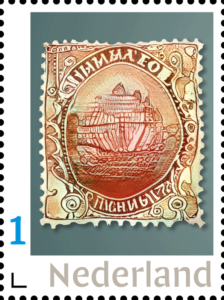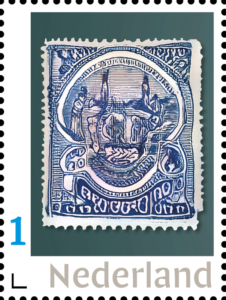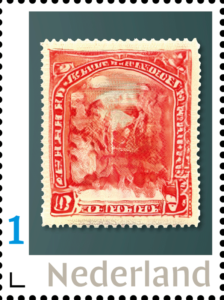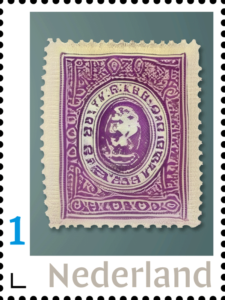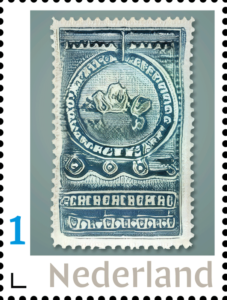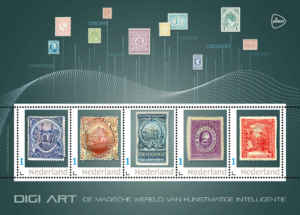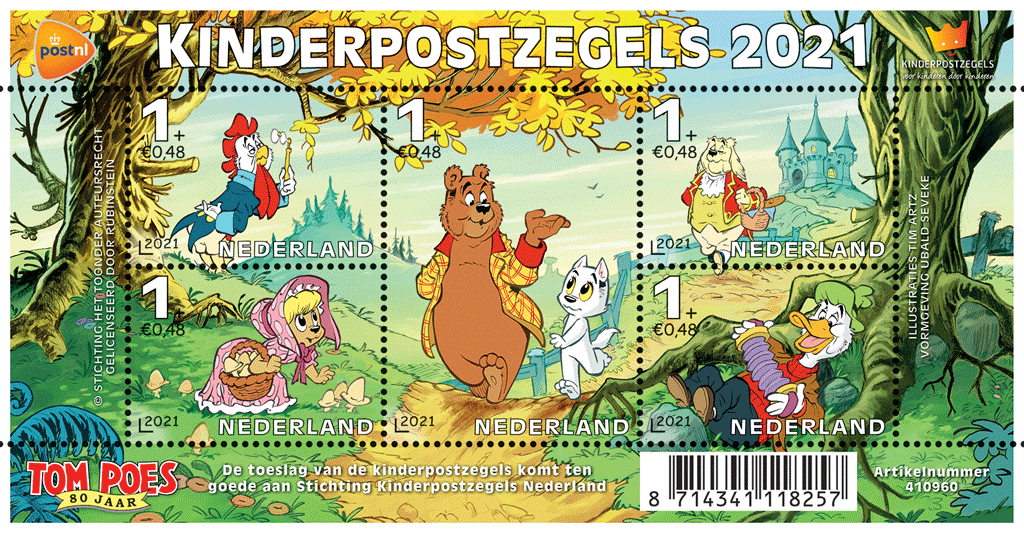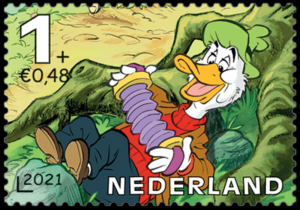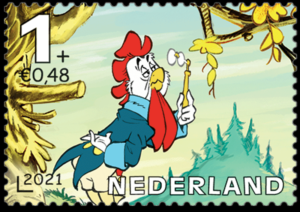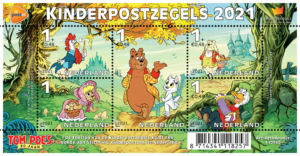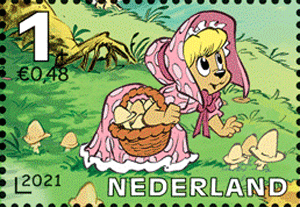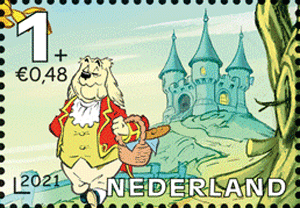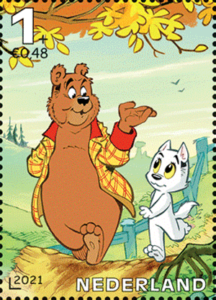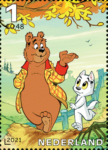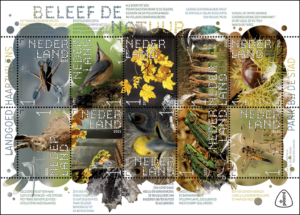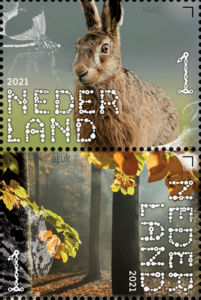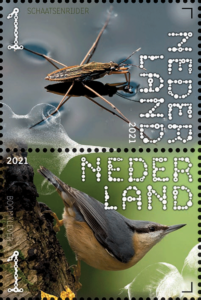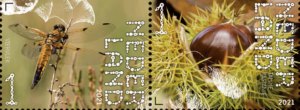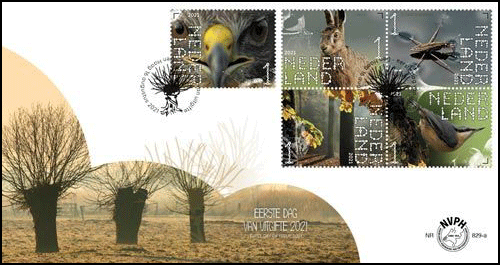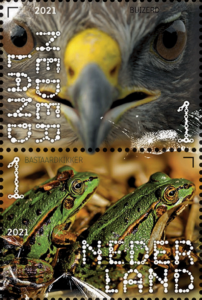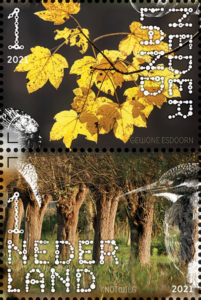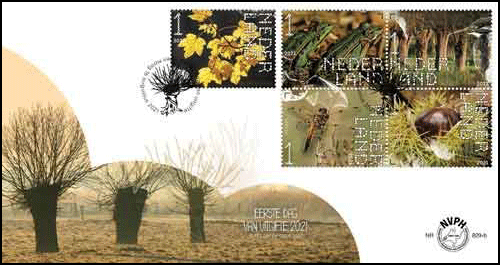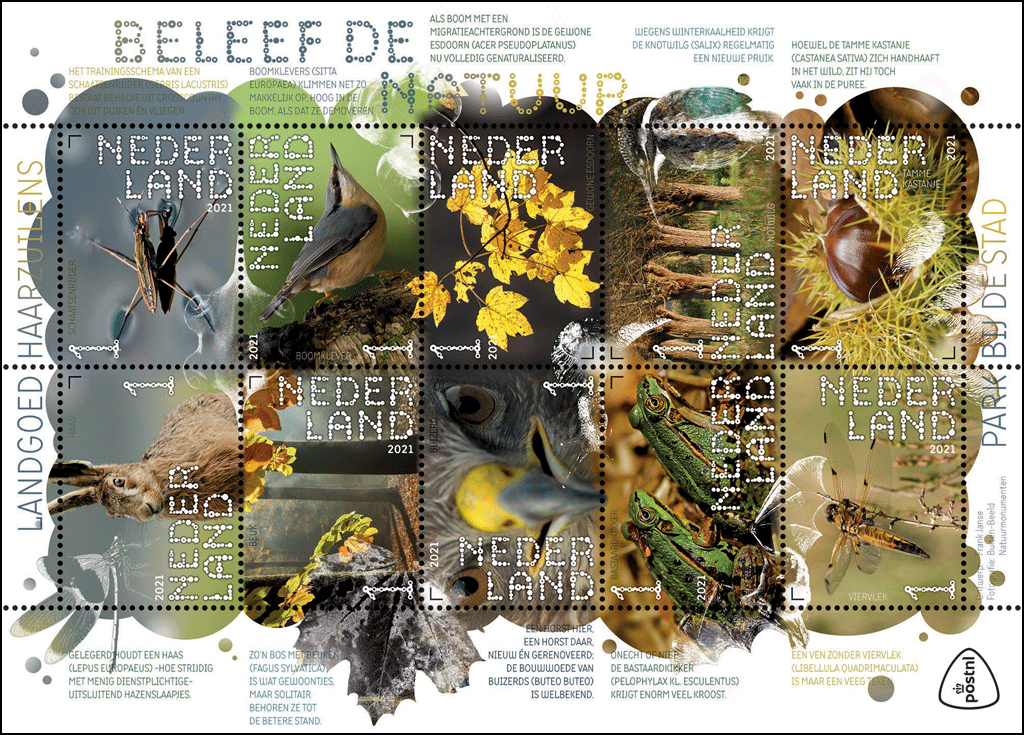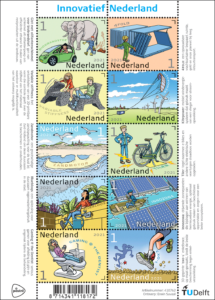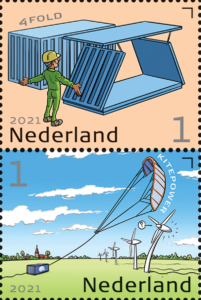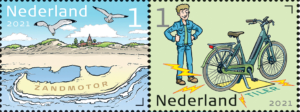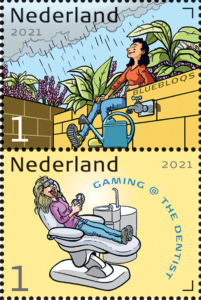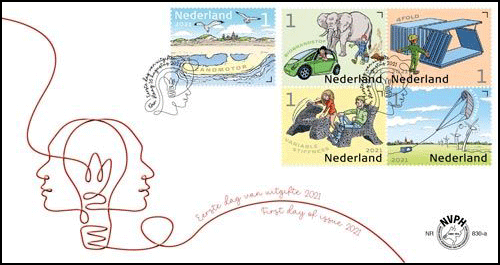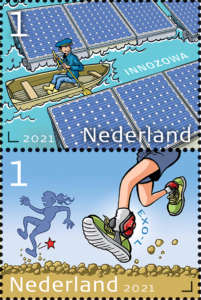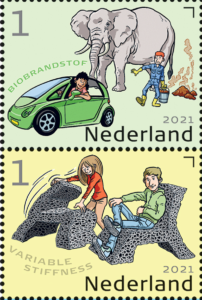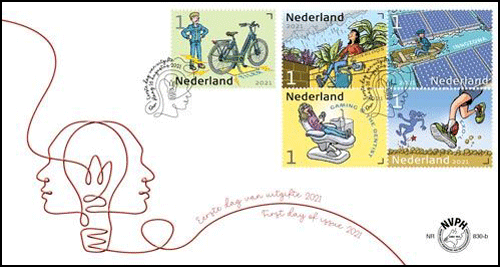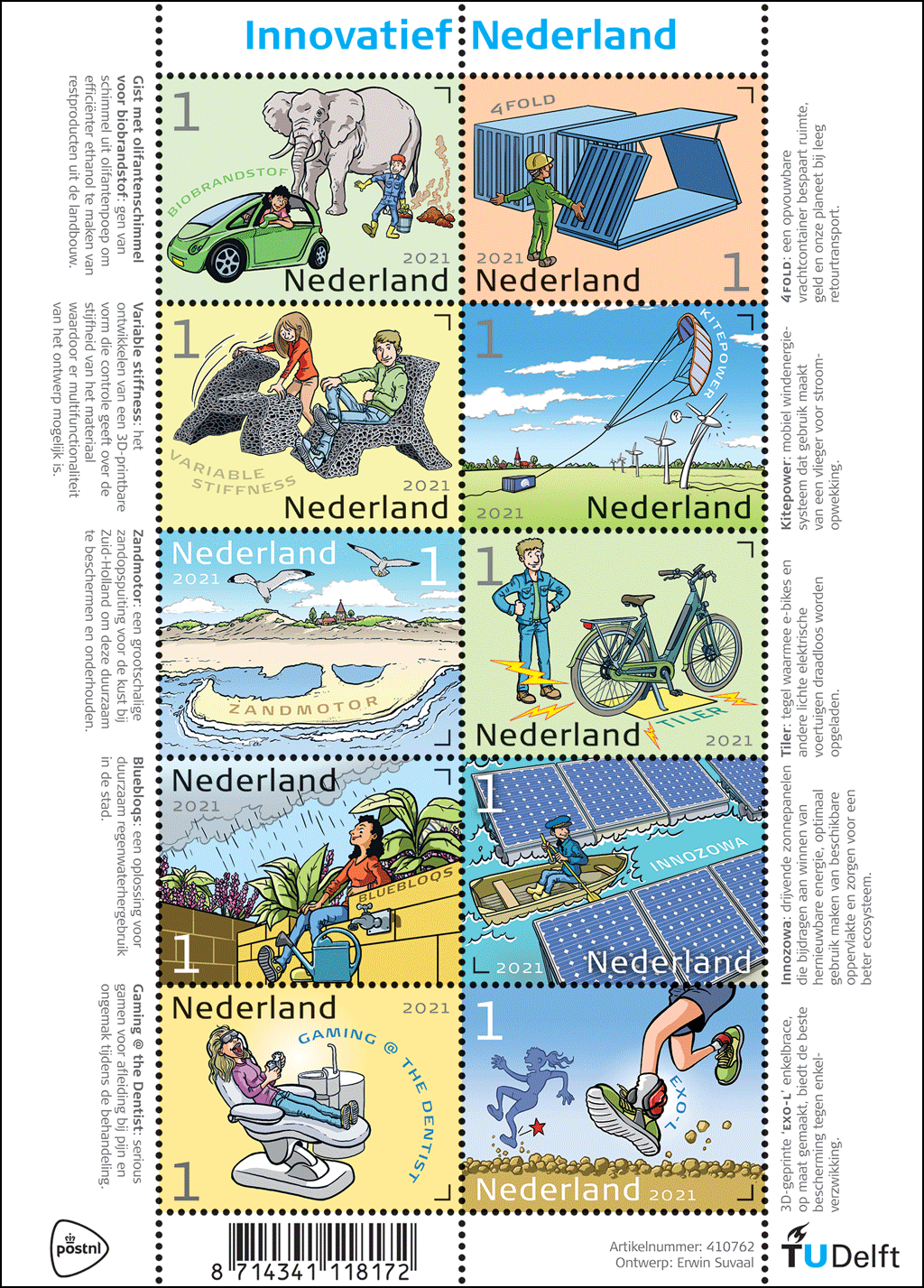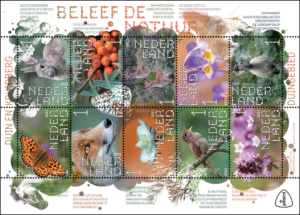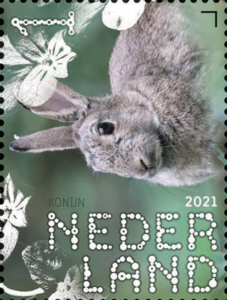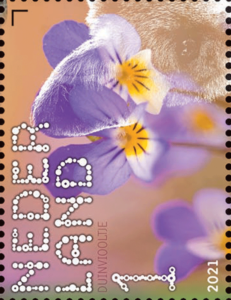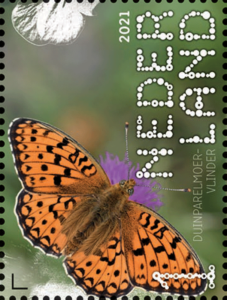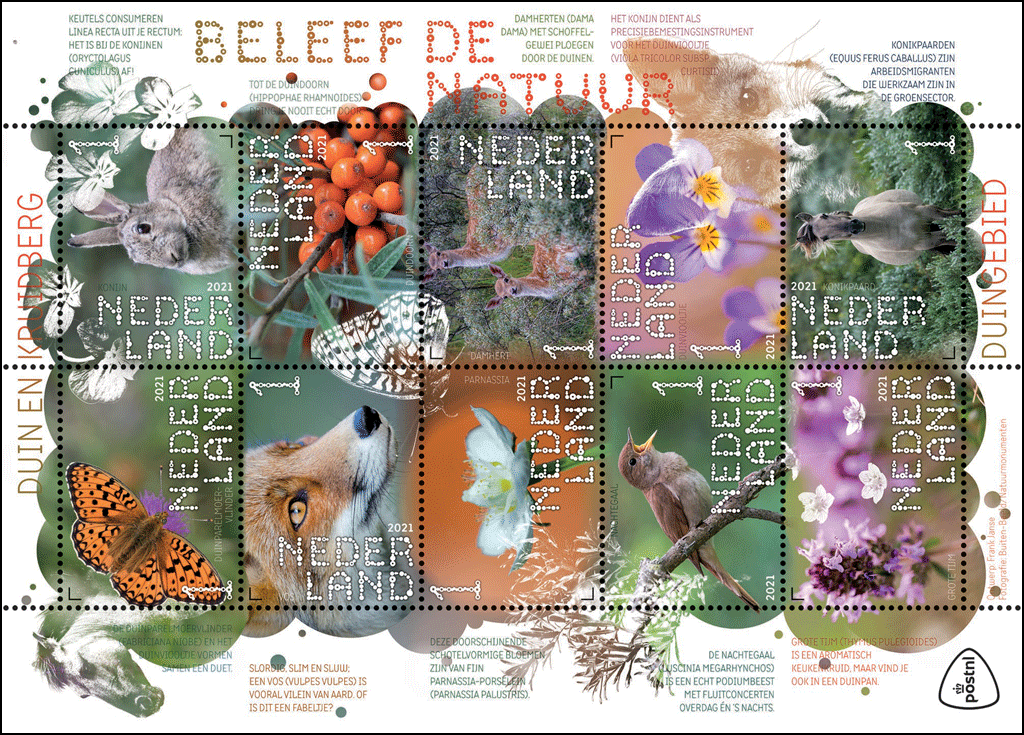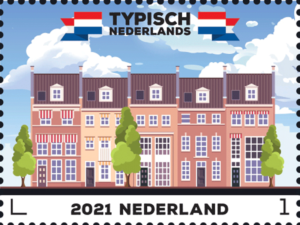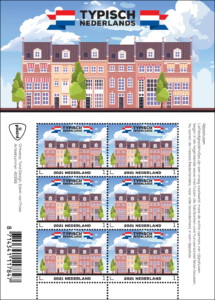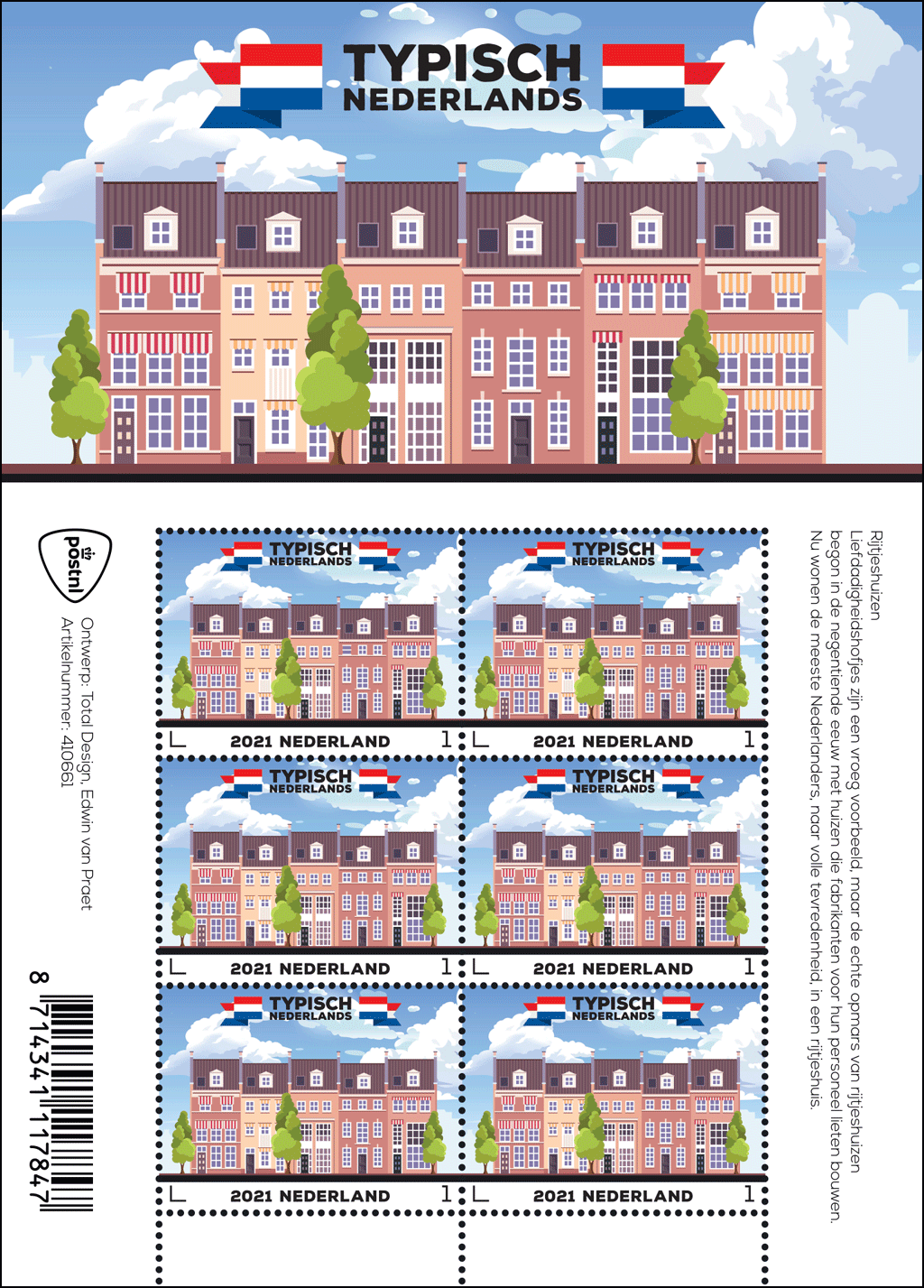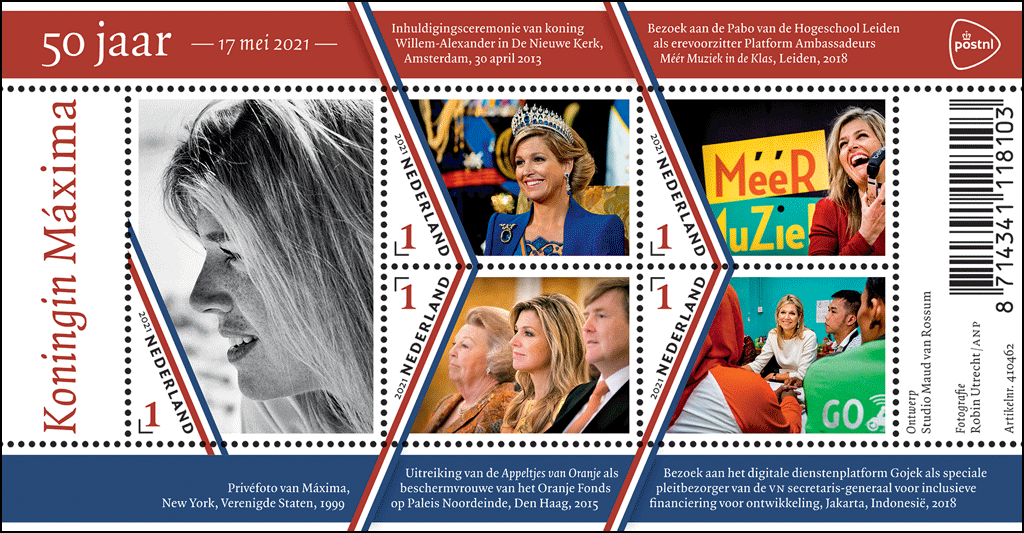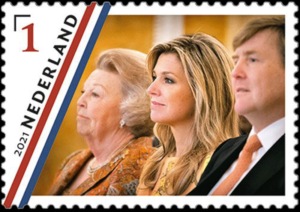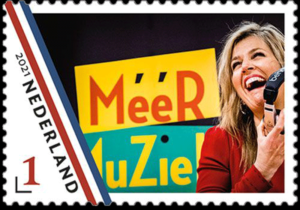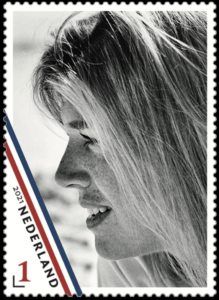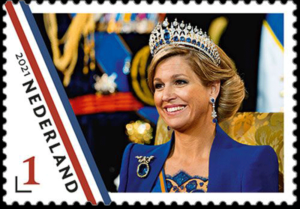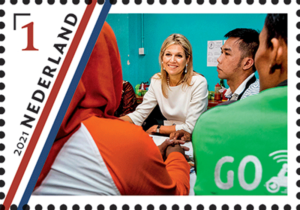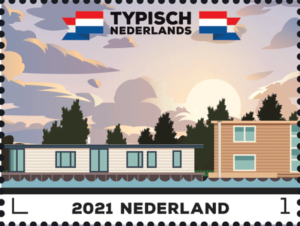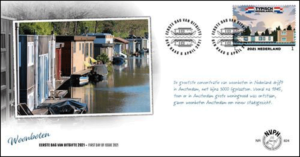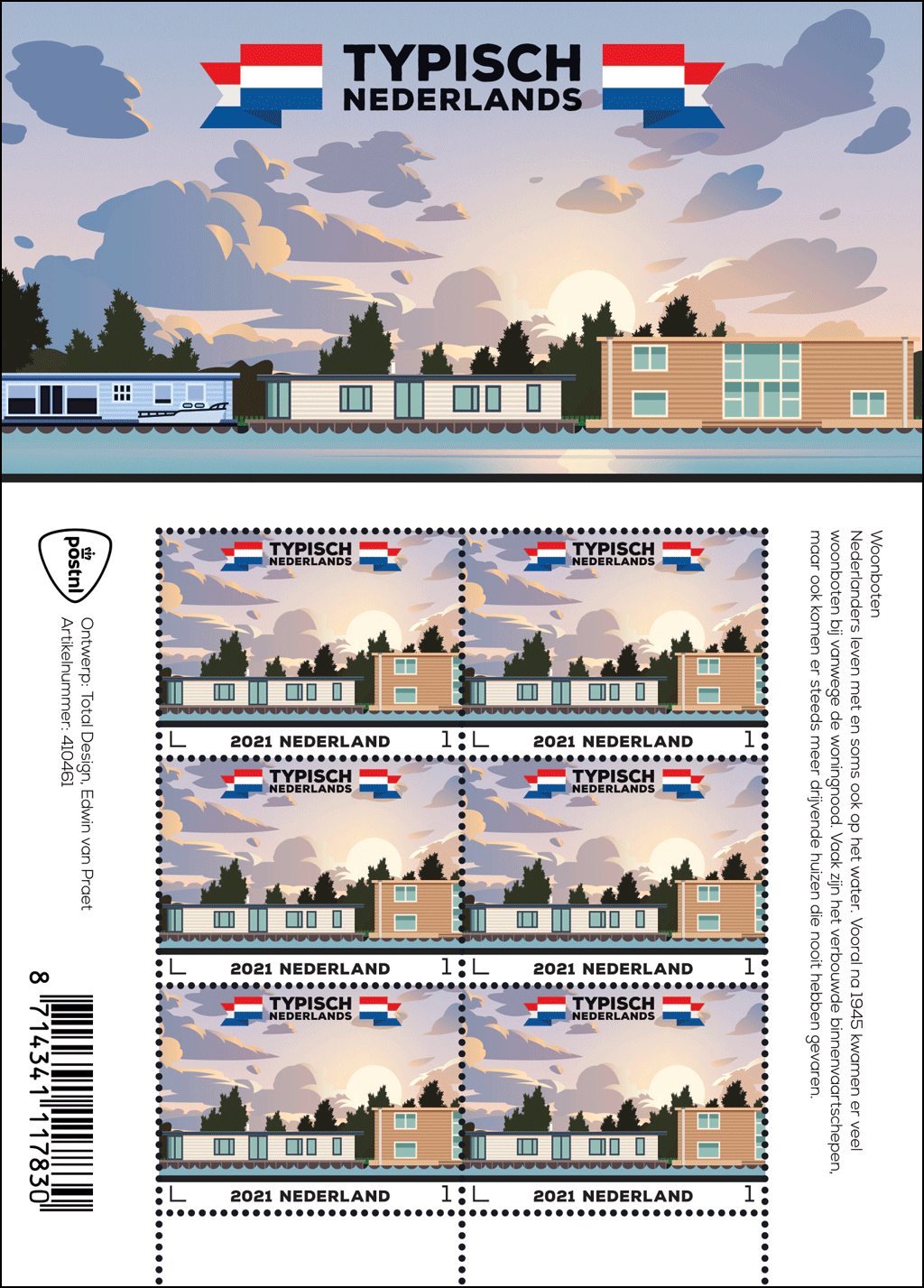[press release]
December Stamps 2021
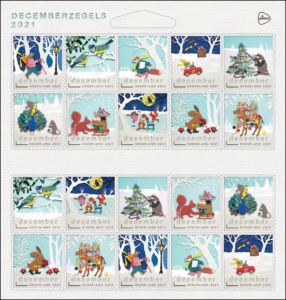 Date of issue: 15 November 2021
Date of issue: 15 November 2021
Appearance: sheetlet of twenty December stamps in ten different designs, with a special December rate for destinations in the Netherlands
Item number: 411261
Design and illustration: Geertje Aalders, Kampen
Graphic design: Corine Zwier, Kampen
Image processing: Ro de Boer, Haarlem
Each year, PostNL issues new December stamps, which can be used by consumers and companies to send each other Christmas and New Year cards at a reduced rate. The special December rate of € 0,91. per stamp applies from 15 November 2021 up to and including 6 January 2022. This year, a sheet of twenty December stamps costs € 18,20. When purchasing two sheets of December stamps, each customer receives a free Christmas decoration especially designed for PostNL by Vondels. This ornament is in the shape of the red postal car that appears on one of the 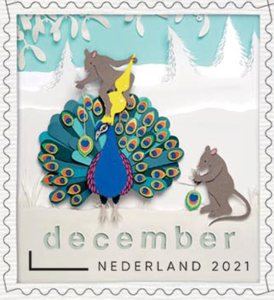 December stamps. The illustrations for the December stamps 2021 were made by paper cutting artist Geertje Aalders from Kampen.
December stamps. The illustrations for the December stamps 2021 were made by paper cutting artist Geertje Aalders from Kampen.
The illustrations on the December stamps 2021 are papercuts, specially made for this issue by paper cutting artist Geertje Aalders. For this year’s December stamps, she has invented a fantasy world full of stories in which a lot happens. In the ten different scenes on the December stamps, all the animals are enjoying the festive month of December. Everyone is doing their best to make it enjoyable for each other. The hare has fetched a bunch of Christmas roses, and the squirrel is on his way with treats for someone else. In this way, Aalders shows that this time of year it is extra nice to be together and to let people know that we are thinking of them.
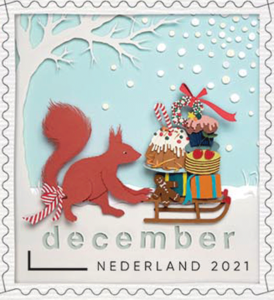 The earliest examples of paper-cutting or cut-out art date from the 3rd century BC. The art of cutting paper is not only part of popular art, but famous modern artists such as Matisse have also worked with it. Famous Dutch cutting artists of the past include Anna Maria van Schurman, Elisabeth Rijberg and Johanna Koerten, who worked in the 17th and 18th centuries. We know that enormous sums were paid for cuttings by Koerten. The Paper Cutting Society was founded in the Netherlands in 1983. In 2013, the society was granted the right to bear the UNESCO logo after paper cutting was placed on the Dutch National Inventory of Intangible Heritage as a craft. The Paper Cutting Museum is located in Westerbork. Other important collections can be found in the Westfries Museum in Hoorn and the Netherlands Open Air Museum in Arnhem.
The earliest examples of paper-cutting or cut-out art date from the 3rd century BC. The art of cutting paper is not only part of popular art, but famous modern artists such as Matisse have also worked with it. Famous Dutch cutting artists of the past include Anna Maria van Schurman, Elisabeth Rijberg and Johanna Koerten, who worked in the 17th and 18th centuries. We know that enormous sums were paid for cuttings by Koerten. The Paper Cutting Society was founded in the Netherlands in 1983. In 2013, the society was granted the right to bear the UNESCO logo after paper cutting was placed on the Dutch National Inventory of Intangible Heritage as a craft. The Paper Cutting Museum is located in Westerbork. Other important collections can be found in the Westfries Museum in Hoorn and the Netherlands Open Air Museum in Arnhem.
The following winter scenes are depicted on the December stamps 2021 in the form of papercuts:
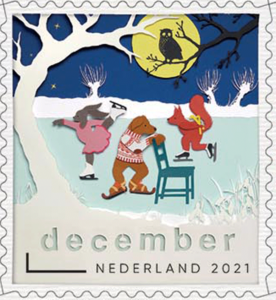 A mole with candy cane and rucksack
A mole with candy cane and rucksack- 2 love-struck blue tits under a mistletoe
- a fox with a fluttering scarf and envelope
- a mouse in a red postal car
- a badger decorating the Christmas tree with his scarf
- 2 mice decorating a peacock
- a squirrel pushing a sleigh with gifts and treats
- a squirrel, hare, dog and owl by the skating pond
- a hare with a bunch of Christmas roses, and
- a fallow deer decorated as a Christmas tree.
All the animals are depicted in a friendly winter landscape, a cosy animal forest with 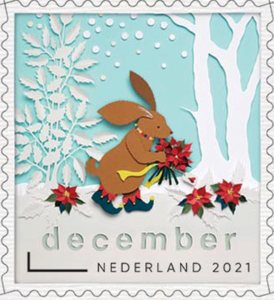 brightly coloured picture elements. Sometimes a larger scene can be seen, other times all the attention goes to one animal. There are three types of sky: light blue, bright blue and dark blue for the morning, afternoon and night respectively. Each December stamp tells its own story. Together, the ten December stamps form a whole because the animals are all, in one way or another, engaged in the theme of Christmas, winter or December.
brightly coloured picture elements. Sometimes a larger scene can be seen, other times all the attention goes to one animal. There are three types of sky: light blue, bright blue and dark blue for the morning, afternoon and night respectively. Each December stamp tells its own story. Together, the ten December stamps form a whole because the animals are all, in one way or another, engaged in the theme of Christmas, winter or December.
Typography
For the title of the issue, the December indication on the stamps and the header on the back, round letters hand-cut by Geertje Aalders were used. For the remaining typography, the Gilroy Regular (by letter designer Radomir Tinkov, 2016) and the Alte Haas Grotesk (letter designer Yann le Corroler, 2007) were used.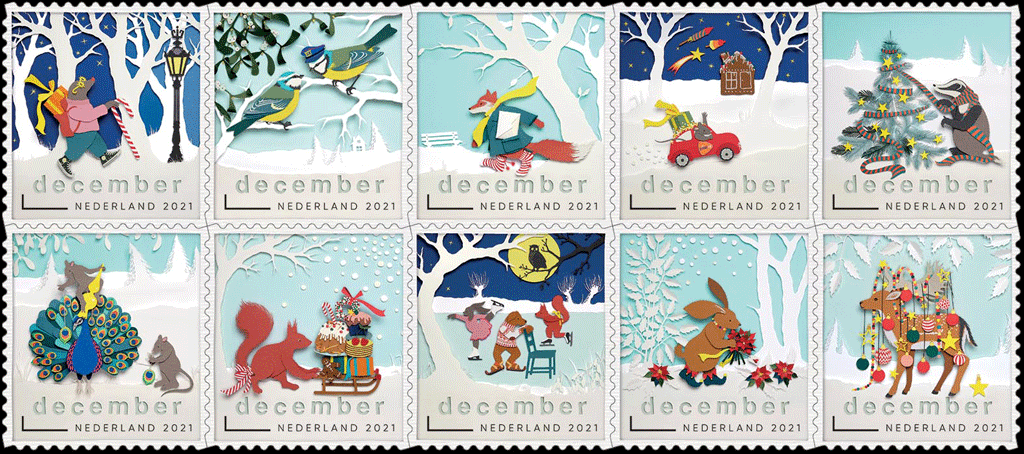
Designer
The creation of the December stamps is always a highlight of the PostNL issue programme. The large circulation, the Christmas and end-of-year feeling, the accompanying publicity campaign – everything is different. This applies all the more this year because the illustrations on the December stamps are, for the first time, based on cutting works of art made of paper. These papercuts were made by illustrator Geertje Aalders from Kampen.
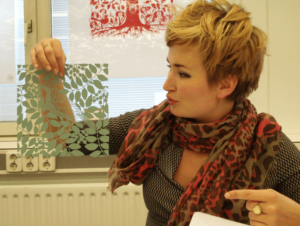 Geertje Aalders (right) has been active as a paper cutter since 2006, among other things for magazines and books. Despite her extensive experience, the December stamps were a very special commission for her as well. “It was already great to see how something like that comes about. On the one hand, there is a lot of structure in the planning and organisation, on the other hand, I was given all the freedom to do what I wanted to do. Really wonderful. It was more than fantastic to be able to work on this commission.”
Geertje Aalders (right) has been active as a paper cutter since 2006, among other things for magazines and books. Despite her extensive experience, the December stamps were a very special commission for her as well. “It was already great to see how something like that comes about. On the one hand, there is a lot of structure in the planning and organisation, on the other hand, I was given all the freedom to do what I wanted to do. Really wonderful. It was more than fantastic to be able to work on this commission.”
Aalders started writing before she started cutting. “I often do that, making up little stories 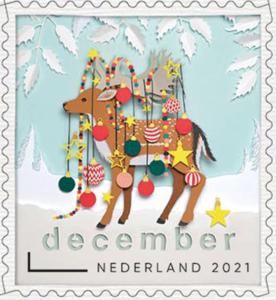 first, like this one about the animals in the forest, with a shared story. Only then did the sketches come. The special thing about papercuts is that you have a beginning and an end, but you cannot show halfway through what it is going to be. Hence the stories and the sketches. I also made a colour chart and completely worked out and cut one of the December stamps – the one with the mole on it – beforehand.”
first, like this one about the animals in the forest, with a shared story. Only then did the sketches come. The special thing about papercuts is that you have a beginning and an end, but you cannot show halfway through what it is going to be. Hence the stories and the sketches. I also made a colour chart and completely worked out and cut one of the December stamps – the one with the mole on it – beforehand.”
After PostNL had approved the stories, the sketches, the sample stamp and the chosen colours, it was time to make the papercuts. Aalders: “I always use the same knife that my grandmother gave me 30 years ago. To put it more precisely, I use the same holder with a different blade every time. I change the blade often – sometimes every fifteen minutes – because it has to stay razor-sharp. Otherwise the knife may slip. For the December stamps, I used a lot of paper in many colours. For example, each eye on the peacock’s tail consists of at least seven 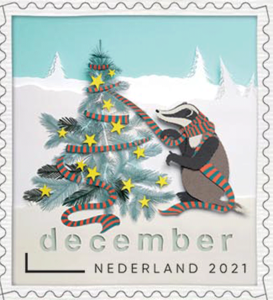 pieces of paper in different colours, one on top of the other. First I cut all the animals and the main objects, like the lamppost, the car, and the gingerbread house. Only then did I start with the surroundings, the trees, and the sky. No two papercuts are the same. A scene with many details takes a lot of time, for example. With others, it is sometimes difficult to get the composition right. I have paid a lot of attention to the smallest details in the silhouette, so that you can quickly see what kind of animal it is. In the mole, for example, the curve at the top of its nose is very important, as is the small hollow under its chin. If it is not right, I will cut it again. Just until I am satisfied.”
pieces of paper in different colours, one on top of the other. First I cut all the animals and the main objects, like the lamppost, the car, and the gingerbread house. Only then did I start with the surroundings, the trees, and the sky. No two papercuts are the same. A scene with many details takes a lot of time, for example. With others, it is sometimes difficult to get the composition right. I have paid a lot of attention to the smallest details in the silhouette, so that you can quickly see what kind of animal it is. In the mole, for example, the curve at the top of its nose is very important, as is the small hollow under its chin. If it is not right, I will cut it again. Just until I am satisfied.”
While cutting, Aalders adds all sorts of details that are not in her sketches. “For example, I cut different kinds of skates for the animals on the frozen pond: Frisian skates, ice speed skates, and figure skates. The blue tit’s post cap is another reference to how you can recognise that bird by its blue cap. I like to include secret jokes in my clippings, like the 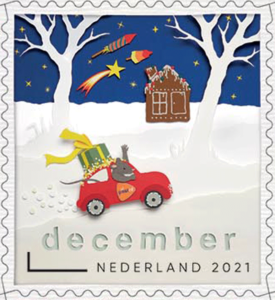 PostNL crown on the lamppost. And there is a rocket in the New Year’s Eve sky, but in the shape of an ice cream.”
PostNL crown on the lamppost. And there is a rocket in the New Year’s Eve sky, but in the shape of an ice cream.”
Aalders cuts in mirror image, i.e. on the back of the paper. “Based on the sketches, I draw the desired contours in pencil. Then I start cutting. Not everything is suitable as a silhouette. For example, a rose is beautiful to look at, but its silhouette is uninteresting. A fox, on the other hand, is beautiful in silhouette, instantly recognisable by its tail and the ears sticking up. I made all the papercuts for the December stamps at the same time. Each stamp is a story in itself, but together they should of course form a beautiful whole.”
The Big Story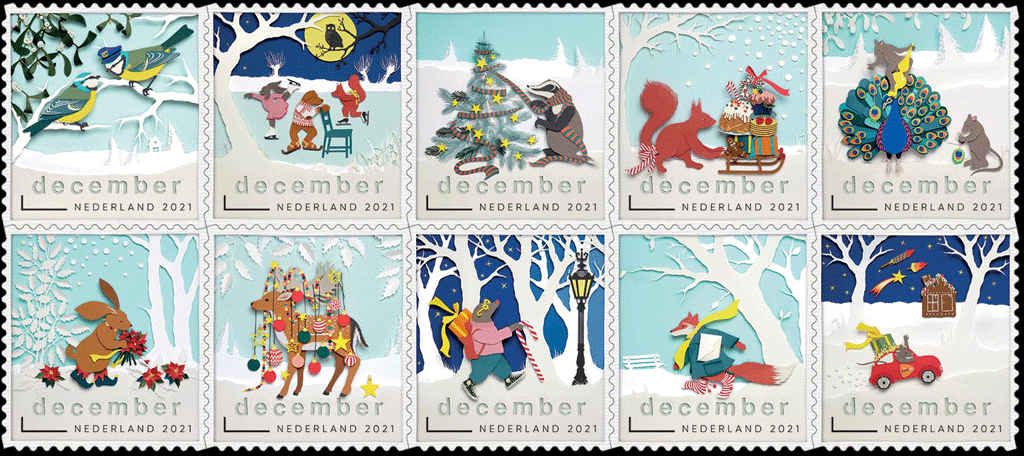 Together, the ten stories on the December stamps tell one big story, in which the animals in the forest are busy celebrating December. “They are decorating the place,” says Aalders. “They are on their way with gifts and mail, and they pay attention to each other. Just look at the kissing blue tits under the mistletoe. Everyone is having a good time. While making the papercuts for the December stamps in the spring, I often thought back to last winter. Then the pond in front of my house was frozen over, children were busy skating,
Together, the ten stories on the December stamps tell one big story, in which the animals in the forest are busy celebrating December. “They are decorating the place,” says Aalders. “They are on their way with gifts and mail, and they pay attention to each other. Just look at the kissing blue tits under the mistletoe. Everyone is having a good time. While making the papercuts for the December stamps in the spring, I often thought back to last winter. Then the pond in front of my house was frozen over, children were busy skating, 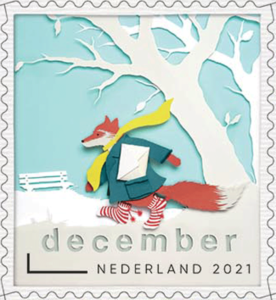 adults were having snowball fights, and everyone was having lots of fun. I wanted to convey that feeling.”
adults were having snowball fights, and everyone was having lots of fun. I wanted to convey that feeling.”
All cut elements are brought together in a three-dimensional frame of usually about 40 x 35 centimetres. Aalders: “I use this to put the papercut together. They are fragile works with a whole framework behind them to connect all the layers of paper. I use pieces of balsa wood, a light and strong type of wood. Not all the paper layers are in a flat plane in the 3D frame. Sometimes I tilt them a little to enhance the spatial effect.”
All frames with the cut-out illustrations for the December stamps were photographed by Aalders herself. “With a special lens, straight from the top. On the basis of the photos, I determined the cutout. Some papercuts have been readjusted and photographed again to get the perfect cutout. For example, I very carefully removed the mistletoe and moved it a little closer to the blue tits. Everything I do is analogue, I don’t adjust anything on the 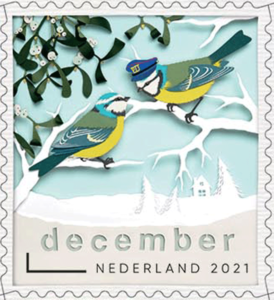 computer. The colours are determined by the paper I choose, the shapes by the way I cut the paper. The only image editing was done by photographer Ro de Boer, with whom I often work. He made sure that the different colours of the sky would have the same intensity. I enlisted more help. Designer Corine Zwier has placed the cut-out letters in the stamps in such a way that it seems as if they have been cut out of the stamp paper. That was her idea. Corine also added a frame to the December stamps with a shadow border, as an imitation of the 3D frame. The background of the sheet was given a relief structure as if it were a real paper sheet.”
computer. The colours are determined by the paper I choose, the shapes by the way I cut the paper. The only image editing was done by photographer Ro de Boer, with whom I often work. He made sure that the different colours of the sky would have the same intensity. I enlisted more help. Designer Corine Zwier has placed the cut-out letters in the stamps in such a way that it seems as if they have been cut out of the stamp paper. That was her idea. Corine also added a frame to the December stamps with a shadow border, as an imitation of the 3D frame. The background of the sheet was given a relief structure as if it were a real paper sheet.”
Order
The final step in making the December stamps was to determine the order on the sheet. “That was a bit of a puzzle,” says Aalders. “Because I wanted as much variety as possible. So preferably no animals with the same colour next to each other, not the same types of sky next to each other, and not the same walking direction of the animals next to each other. Moreover, by giving the bottom block of ten December stamps a different order than the top block, at first sight it looks like a sheet with twenty different designs. I am very happy with the final result, I worked very hard on it. Hopefully, people will also like it and realise that they are cut-out illustrations. The wren on the back of the stamp sheet is the best proof of this. To confirm that everything has been cut, there is a scissor on the back instead of a copyright symbol.”
About The Designer
 Geertje Aalders (Doetinchem, 1983) is a Dutch illustrator who is best known as a paper cutting artist and an authority on modern cutting in the Netherlands. Aalders studied graphical design and illustration at Constantijn Huygens School of the Arts in Kampen and ArtEZ University of the Arts in Zwolle from 2001 to 2008. Since 2006 she has worked as a freelancer for magazines such as Flow Magazine, Happinez, and Margriet. Other well-known clients are Albert Heijn, Bekking&Blitz, and Hema. In addition, Aalders illustrates all kinds of books that are also published abroad. Arab fairy tales (Gottmer Publishers Group) from 2017, with adaptations of fairy tales by Rodaan Al Galidi and with cuttings by Aalders, was awarded the Libris Most Beautiful Book Cover and the Jenny Smelik-IBBY Prize. In addition to cuttings, Aalders makes detailed pen drawings and illustrations in oil. She also wrote a handbook on paper cutting, Het Papercutboek (Kosmos Publishers, 2019).
Geertje Aalders (Doetinchem, 1983) is a Dutch illustrator who is best known as a paper cutting artist and an authority on modern cutting in the Netherlands. Aalders studied graphical design and illustration at Constantijn Huygens School of the Arts in Kampen and ArtEZ University of the Arts in Zwolle from 2001 to 2008. Since 2006 she has worked as a freelancer for magazines such as Flow Magazine, Happinez, and Margriet. Other well-known clients are Albert Heijn, Bekking&Blitz, and Hema. In addition, Aalders illustrates all kinds of books that are also published abroad. Arab fairy tales (Gottmer Publishers Group) from 2017, with adaptations of fairy tales by Rodaan Al Galidi and with cuttings by Aalders, was awarded the Libris Most Beautiful Book Cover and the Jenny Smelik-IBBY Prize. In addition to cuttings, Aalders makes detailed pen drawings and illustrations in oil. She also wrote a handbook on paper cutting, Het Papercutboek (Kosmos Publishers, 2019).
Limited Validity
The 2021 December stamps are available from 15 November 2021 at all PostNL sales 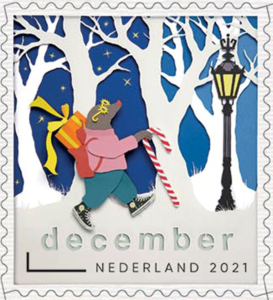 outlets in the Netherlands and through www.postnl.nl/collectclub. The stamps can also be ordered by phone from the Collect Club customer service on +31 (0)88 868 99 00. The validity period is indefinite, but the December stamps can only be used on their own from 15 November 2021 up to and including 6 January 2022.
outlets in the Netherlands and through www.postnl.nl/collectclub. The stamps can also be ordered by phone from the Collect Club customer service on +31 (0)88 868 99 00. The validity period is indefinite, but the December stamps can only be used on their own from 15 November 2021 up to and including 6 January 2022.
The December stamps with the special rate are intended for use on mail weighing up to 50 g and on envelopes with minimum dimensions of 14 x 9 cm that are destined for delivery in the Netherlands in the period from 15 November 2021 up to and including 6 January 2022. Two December stamps are enough for mail weighing up to 50 g destined for delivery to addresses outside the Netherlands. December stamps can also be used outside of the period from 15 November 2021 up to and including 6 January 2022, provided that they are accompanied by an extra stamp for the rate applicable at the time of sending.
Stamp size: 26.5 x 29 mm
Sheet size: 144 x 151 mm
Paper: normal with red phosphor print
Glue: self-adhesive
Printing technique: offset
Printing colours: cyan, magenta, yellow, and black
Print run: 3,615,000 sheets
Appearance: sheet of 20 stamps with 10 different designs
Design: Geertje Aalders, Kampen
Graphic design: Corine Zwier, Kampen
Image processing: Ro de Boer, Haarlem
Printing company: Koninklijke Joh. Enschedé B.V., Haarlem
Item number: 411261 